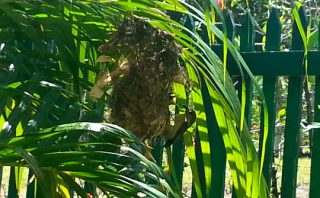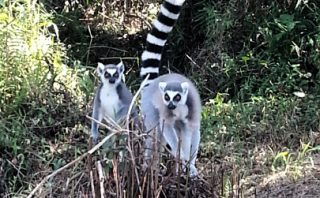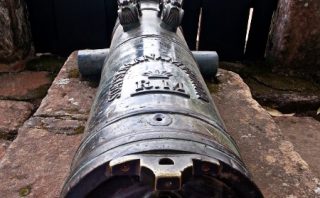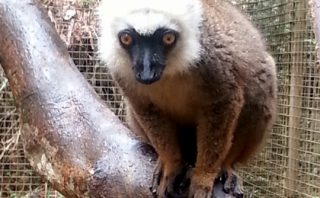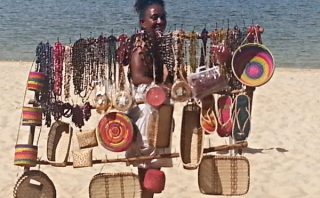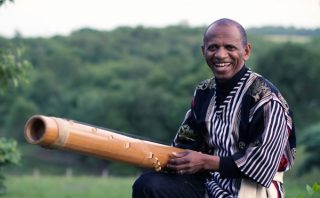Today is Wednesday and we’re driving to Tuesday. Tuesday is only a few kilometers away not next week. Talata is Malagasy for Tuesday. Yesterday, a shopkeeper in Antsirabe told us that the silk scarves they were selling were made in Talata. Talata is on the way to Betafo, our destination, so Tuesday becomes our first stop.
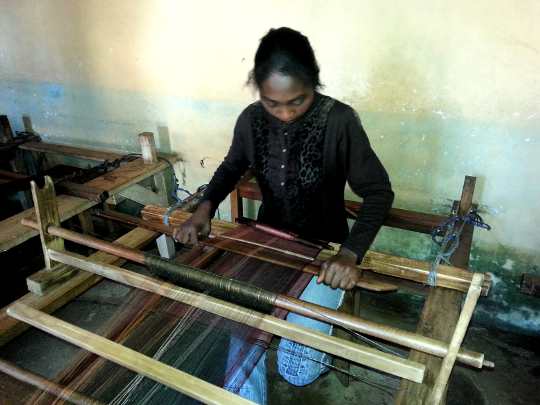
We find a silk workshop on the road through town. A man greets us and offers to show us around. His name is Hilaire Ranoasy. I ask him if he’s the boss. He says no, he just works there.
They process both wild and cultivated silk here. We’re shown inside where people are spinning and weaving. We are shown outside where silk is being dried on a line, and colored with die in a pot over a fire. We’re shown raw wild and cultivated cocoons. And, of course, we’re taken to a showroom where we can buy finished silk products.
Malagasy Silk
Silk has been a part of Malagasy culture for a long time. Traditionally, silk comes from the endemic silk worm Borocera madagascariensis. The cocoons are gathered in the wild from tapia trees, then hand spun and woven. The silk is used to make lamba, fabric and garments traditionally worn first by Malagasy royalty and now by all Malagasy people in the form of scarves, shawls, and even burial shrouds.
In parts of Madagascar, people are now restricted from the land they traditionally used for their livelihoods due to wildlife habitat protection, which is mainly the national parks. Cultivating and collecting wild silk cocoons and making silk lamba is becoming an income generating alternative for these people.
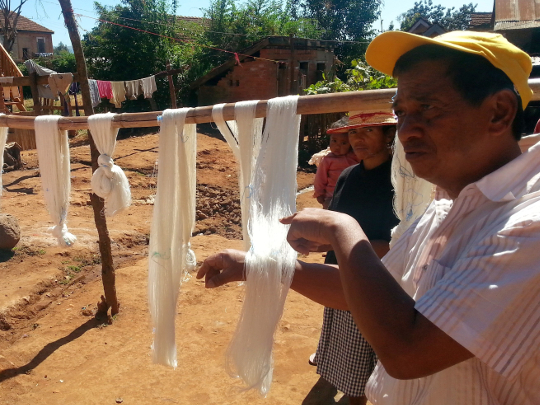
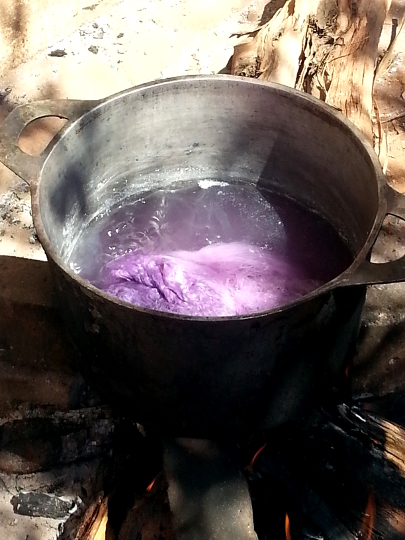
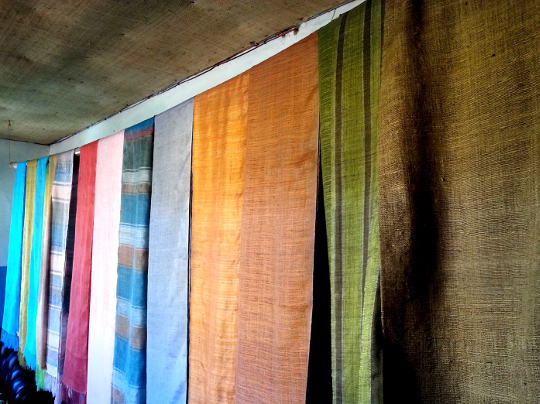
The cultivated silk worm, Bombyx mori, were brought to Madagascar around 1850. Madagascar has three silk centers. One of these centers is in Antsirabe. In addition to promoting the silk industry, the centers produce and distribute cultivated silk worm eggs to farmers. The farmers raise the cultivated silk worms on mulberry, of which there are about 200 hectares in Madagascar.
You can read more about silk in Madagascar at International Sericultural Commission – Madagascar, and Conservation through Poverty Alleviation International – Madagascar.
Raffia Basket Side Trip
We look around in the shop a bit. Lori buys a number of scarves for gifts for family and friends back home. Hilaire asks if we want to see where they make raffia baskets. I ask how far away, can we walk there? It’s a couple kilometers. It’s getting hot out. We choose to take the car. A man from Le Murier comes along to show us the way.
As we walk out of the workshop, a little girl in a nearby school bus exclaims, “Vazaha!” I look up. She has ducked down and is peeking out through the window. I smile and point at myself, “Vazaha zahoa (I’m vazaha).” She smiles back.
Vazaha is Malagasy for foreigner with white skin, and also people with soft feet. Although my feet aren’t so soft anymore. Tropical living does this. I’m barefoot most of the time. Just wear flip flops or sandals when I have to.
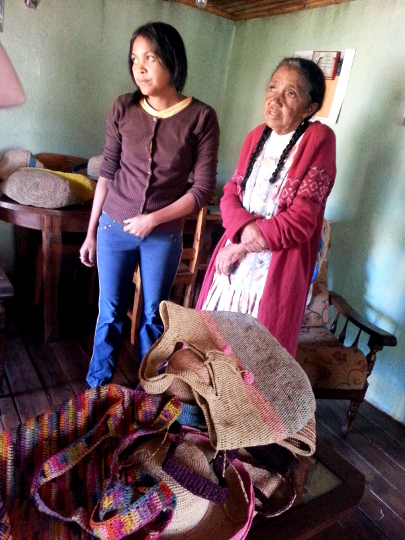
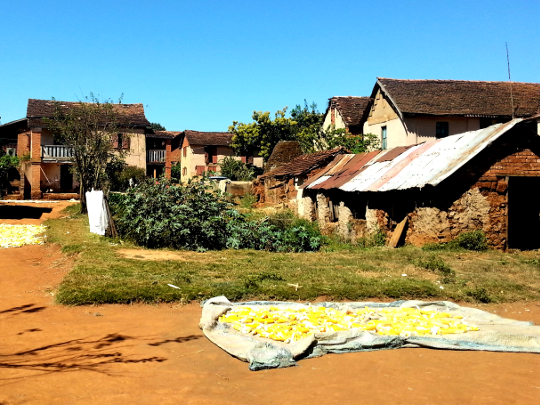
We drive along narrow, twisty dirt roads and past a few villages. We get a lot of stares from the locals. We smile and wave. Our passenger directs us to turn in amongst a group of houses.
A cultural aside. Malagasy in general are helpful and want to be helpful. Sometimes this helpfulness results in best guesses or any answer is better than answering “no” or “I don’t know.” If you ask for directions to somewhere and the person you asked doesn’t know, you’re quite likely to get directions anyway and a little adventure following them. I had asked how far to walk to see the raffia baskets and got an answer. Our drive took us a half hour at about 10 miles per hour (16 kilometers per hour), which means the distance was closer to five miles (8 kilometers). Good thing we took the car. A ten mile round trip walk under the hot afternoon sun would not have been an enjoyable adventure.
The houses are built with timber frames and bricks made by hand in the rice fields. Corn is laid out and drying in the yards. I ask if the corn is for people or livestock to eat. They say for people. Maybe they’re going to sell it to the Three Horse Beer brewery. THB is made with both barley and corn and the brewery buys these from local farms. But I don’t have the Malagasy vocabulary to ask all that.
Some ladies are making raffia baskets. Their workshop is on the first floor of a house. We are invited upstairs to look at finished baskets and hats. Lori buys a few for gifts. As she negotiates the price, I appreciate the Malagasy home. A clean, comfortable, cared for home.
I wonder about daily life here and the richness or poorness of it. Maybe it’s rich in the stories of the family, and the plantings, harvests, holidays, and celebrations that mark the year for them. Maybe it’s poor in the hardship of the work, the lack of possessions, the limit of choices and opportunities. Maybe this is poor by developed nation standards. But I don’t know if these people feel poor.
A Batik Workshop
On the way out of Talata, we see a sign for “Art Batik.” We stop. The artist, Francois Ricman, invites us into his showroom. Then he asks if we would like to watch him paint. Yes, we would. From the smell of it, his waxes and paints might be a bit hazardous. Maybe these are all that are available. He paints scenes of rural Malagasy central plateaux life. Maybe they’re a bit touristy. But the vivid colors he uses raises the work above touristy for me.
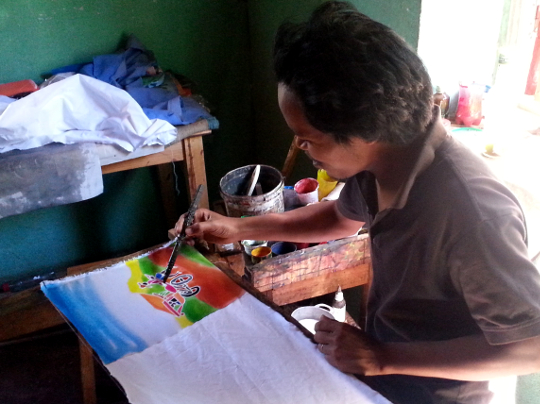
A number of children are playing about the yard. I ask if I can give them some candies. There are a lot of smiles, and shy “thank-yous” in English.
It’s lunch time already. As we pass Lake Andraika, hotel and guesthouse signs advertising restaurants catch our hungry attention. We pull into Hotel Laza and enjoy a quiet lunch with views over the lake.

